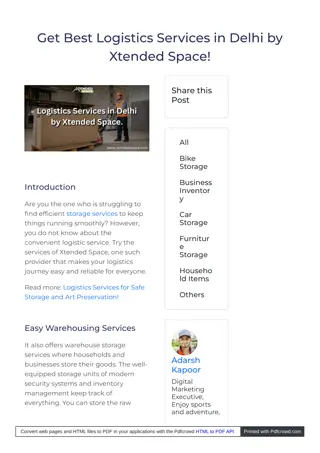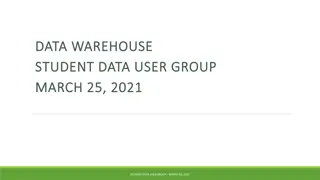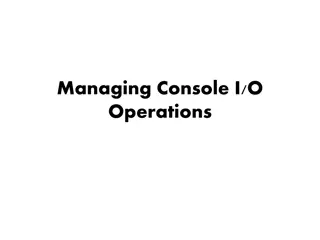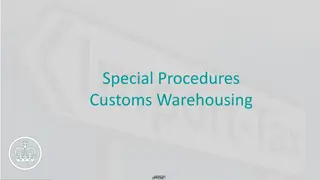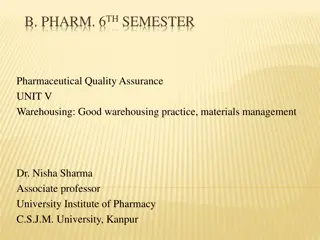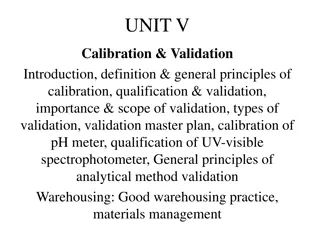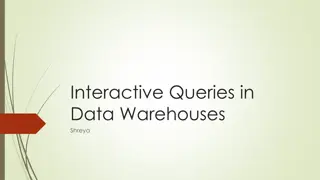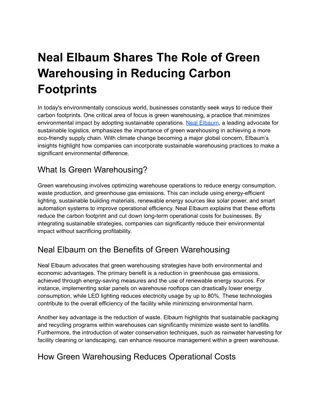Introduction to Warehousing Operations: Key Concepts and Functions
Warehousing operations involve the management and control of inventory within storage facilities. Personnel perform tasks such as receipt, storage, retrieval, and distribution of goods. The functions within warehouses have evolved to include services like cross-docking and kit assembly, enhancing their role in the supply chain. Warehouse Management Systems play a crucial role in integrating operations with ERP systems and material handling equipment to streamline processes.
- Warehousing Operations
- Inventory Management
- Supply Chain
- Storage Facilities
- Warehouse Management Systems
Download Presentation

Please find below an Image/Link to download the presentation.
The content on the website is provided AS IS for your information and personal use only. It may not be sold, licensed, or shared on other websites without obtaining consent from the author. Download presentation by click this link. If you encounter any issues during the download, it is possible that the publisher has removed the file from their server.
E N D
Presentation Transcript
Common Learning Blocks Learning Block 4 Warehousing Operations
Course Agenda 1. Supply Chain Management Principles 2. Demand Planning 3. Supply Management and Procurement 4. Warehousing Operations 5. Inventory Management 6. Manufacturing and Service Operations 7. Transportation Operations 8. Customer Service Operations 2
Warehousing Operations Learning Block 4
Description Warehouses are physical buildings or structures to store inventory. Warehousing operations are the process that enable the control and management of inventory. 4
Learning Objectives Explain the purpose of a warehouse Define the functions that occur in a warehouse Understand value-added operations in a warehouse
Overview Warehousing personnel perform the receipt, storage, retrieval, and distribution of procured goods and materials. Warehouses are not always standalone facilities. In some cases, the storage of raw materials, work in process, and finished goods use dedicated portions of the manufacturing facility. In other cases, warehouses and distribution centers may have roles that are entirely focused on storage.
Overview Functions performed within warehouses or distribution centers have increased significantly, so this function now plays a greater role in the overall supply chain. Warehouses designed to function as distribution centers can provide additional services for customers, such as cross-docking and kit assembly. Cross-docking: Moves incoming product to outgoing trucks. Kit assembly: picking up multiple items and placing them into one kit.
Overview Warehousing is supported by a warehouse management system (WMS) that is linked to a company s ERP system. The WMS is integrated with the material handling systems, which includes equipment to move, stock, pick, and route goods in and out of warehouses and distribution centers.
Practice Questions 1. Which task is normally not performed by warehousing personnel? a. Unloading incoming items from trucks b. Processing inventory within the warehouse c. Paying suppliers d. Inspecting incoming items Identify the function that is performed by warehousing personnel when manufacturing has a demand for stored inventory. a. Packaging for shipment b. Paying an invoice c. Retrieving or picking d. Calling customer service 2.
Practice Questions 3. Automated material handling systems are designed to: a. Completely eliminate jobs b. Increase speed and accuracy c. Decrease reliability d. Increase costs 4. An example of a value-added function in a warehouse is: a. Picking b. Receiving c. Storing d. Cross-docking
Practice Questions 5. Inventory is managed and controlled with the aid of: a. Warehouse management systems b. Receiving docks c. Conveyors d. Truck ramps



